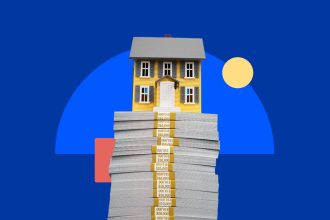Image by GettyImages; Illustration by Bankrate
In 2025, U.S. savers are showing less willingness to move their money between banks, a notable shift from the deposit flight and rate-chasing behavior seen in prior years. This inertia comes at a significant cost: With deposit growth slowing and consumer mobility declining, banks have little incentive to boost savings rates, potentially leaving less savvy savers earning pennies while inflation erodes their purchasing power.
So what’s going on? To put it simply, people aren’t moving their money, and banks aren’t giving them much reason to. Here’s what you need to know.
Deposit competition has cooled
To understand why savers are losing out, you need to understand how bank competition works.
When interest rates were rising in 2022 and 2023, banks scrambled to keep depositors from walking out the door. That created a golden moment for savers. Online banks and credit unions were offering 5 percent APY or more on high-yield savings accounts, hoping to lure in and retain rate-sensitive depositors.
But in 2025, the dynamic has changed fundamentally.
Historically, banks increase rates to attract deposits when they need to fund loans or meet liquidity requirements. But with deposit supply outpacing demand, especially in a stable economic environment, the pressure to offer competitive rates diminishes.
The Federal Reserve stopped raising U.S. interest rates in 2024 and later began cutting them. Without that pressure, banks have not been compelled to compete aggressively for deposits. The result? Savings rates have flatlined.
The average rate on a standard savings account has remained somewhat flat since January. This applies to both traditional financial institutions — credit unions and banks — and fintech companies. The flat trend suggests that most consumers are not moving their money to take advantage of better rates, and that banks have stopped trying to lure in savers by racing to offer higher yields.
Why consumers aren’t taking action
Despite the widespread availability of high-yield savings accounts still offering rates above 4 percent, most Americans aren’t moving their money to take advantage. According to a recent Bankrate survey, two-thirds of savers are earning an APY of less than 4 percent.
Almost one in five (17 percent) say they aren’t earning any interest on their short-term savings, the survey found.
Traditional savings accounts at large brick-and-mortar banks typically offer yields as low as 0.01 percent to 0.25 percent APY — a fraction of what’s available from online banks.
Several factors explain this consumer inertia:
This means that, unless consumers take the initiative to move their money, their savings could languish in low-yield accounts for much of 2025.
The real cost of staying put
With national average savings rates still hovering near historic lows, the opportunity cost of staying put is significant. Even a modest difference in rates can translate into hundreds of dollars in lost interest over a year for households with substantial balances.
Here’s the long-term impact of staying in a low-yield account, assuming you have $10,000 to deposit:
| Type of account | APY | 10-year ending balance | Interest earned |
| Traditional savings account | 0.42% | $10,428.03 | $428.03 |
| High-yield savings account | 4.00% | $14,802.44 | $4,802.44 |
Beyond the immediate lost interest income, savers face an additional threat: inflation erosion. In simple terms, if your savings account isn’t paying a yield above the rate of inflation you are literally losing money.
How savers can make their money work harder
Given the current environment, proactive savers can still find opportunities to boost their returns:
What to expect moving forward
Based on current Federal Reserve policy and banking industry trends, savers should expect continued rate stagnation unless economic conditions change dramatically. Banks will likely maintain current deposit rates without competitive pressure from rising Fed rates.
The battle for consumer deposits might be slowing in 2025, but that doesn’t mean you should accept subpar returns on your savings. Smart savers can still earn competitive yields by taking action.
Check your savings rate, shop around, and don’t be afraid to move your money if a better deal pops up. If you want your money to work harder in 2025, you may need to make the first move — because your bank probably won’t do it for you.
Read the full article here














